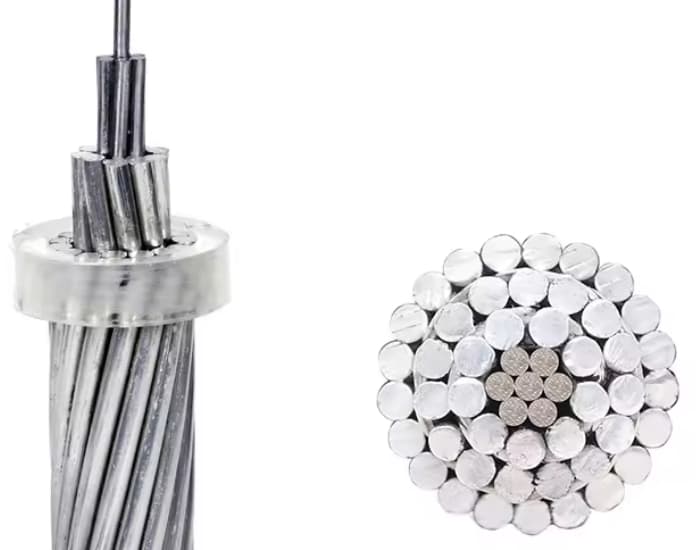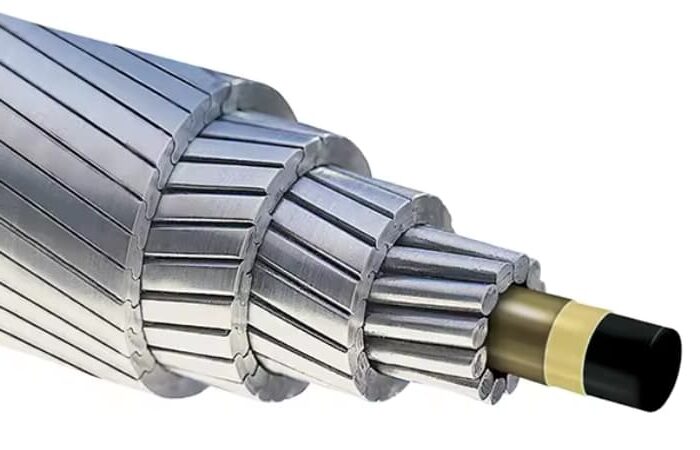
ACSR drivers (Aluminum Conductors Steel-Reinforced) y ACCC (Aluminum Conductor Composite Core) differ significantly in several aspects, such as the composition of the material, performance characteristics and application advantages.
1.ACSR and ACCC conductor material composition
Conductor ACSR: made of braided aluminum and steel wires, with the steel wires acting as the core and the aluminum wires wrapped around the steel wires. This structure makes the ACSR conductor not only have the good electrical conductivity of aluminum, but also the high strength and tensile properties of steel.
Conductor ACCC: More advanced composite technology is used, The core is composed of carbon fiber and fiberglass composite core, the outside is wrapped with aluminum wire. This composite core design makes the ACCC conductor maintain high resistance, but also has lighter weight and better corrosion resistance.
2.Performance characteristics of ACSR and ACCC conductors
electrical conductivity: Both have good electrical conductivity, but ACCC conductors typically outperform ACSR due to the use of higher purity aluminum wires and optimized structural design.
Mechanical strength: He conductor ACSR, with its steel core, Provides sufficient mechanical strength and tensile properties to be suitable for a variety of complex overhead transmission line environments. Although the ACCC conductor also has great mechanical resistance, Its composite core design makes its resistance characteristics more balanced, and in some aspects (such as fatigue resistance) they may be better than the ACSR driver.
Corrosion resistance: The composite core material of ACCC conductors has excellent corrosion resistance and is capable of long-term stable operation under harsh environmental conditions.. On the contrary, steel core ACSR conductors, although galvanized and with other anti-corrosion treatments, may continue to be affected by corrosion in extreme environments.
3.Advantages of the application of ACSR and ACCC conductors
Conductor ACSR: due to its simple structure, easy assembly and maintenance, low line cost and other features, It is widely used in various voltage levels of overhead transmission and distribution lines. The advantages of the ACSR driver are especially evident when you have to traverse special geographical conditions, like rivers and valleys.
Conductor ACCC: With its greater current carrying capacity, less line loss, longer life and better corrosion resistance, has become a new type of conductor to solve the challenges of modern energy transmission, etc. ACCC driver is especially suitable for occasions where transmission capacity needs to be increased, reduce energy consumption and minimize environmental impact.
4.ACSR and ACCC conductors Current carrying capacity
ACSR: Although ACSR conductors play an important role in power transmission, Its current carrying capacity is limited by its physical characteristics. Due to the presence of a steel core, The conductive area of ACSR conductors is relatively limited, which restricts its use in high capacity transmissions.
ACCC: On the contrary, ACCC conductors have a higher current carrying capacity. Thanks to its carbon fiber composite core and strongly compressed double-layer trapezoidal aluminum filament design, ACCC conductor with the same outer diameter can provide larger aluminum cross-sectional area, thereby increasing the conductive area and improving the current carrying capacity. This feature makes the ACCC driver especially suitable for occasions requiring high capacity power transmission..
5.Arc characteristics of ACSR and ACCC conductors
ACSR: As the temperature increases, the arc deflection of ACSR conductors increases significantly, which can have an impact on the safety and stability of transmission lines. Especially in large-scale, high-temperature transmission projects, ACSR driver bow arrow problem is particularly important.
ACCC: ACCC conductors have less bow deflection variation at high temperatures due to their unique material properties and structural design.. This feature enables the ACCC driver to maintain better stability and safety in large-scale, high-temperature transmission projects..
6.ACSR and ACCC driver Scope of application
ACSR: As the ACSR driver has the advantages of low cost and easy maintenance, It is widely used in overhead transmission and distribution lines of various voltage levels.. Especially in some of the occasions where the current carrying capacity and bow arrow requirements are not high, ACSR driver remains an economical and practical option.
ACCC: ACCC driver is more suitable for transmission capacity, the safety and environmental protection requirements of the highest occasions. Its high resistance, low bow drop, corrosion resistance and long service life and other characteristics make ACCC conductor has become an important development direction in the field of modern power transmission. Especially at the coastal company site, mining areas and other corrosion intensity, high intensity of dirt, driver easy to dance in the environment, The ACCC driver app is particularly broad perspectives.

7.ACSR and ACCC driver Energy saving effect
ACSR: Due to its high resistivity and the existence of the hysteresis effect, ACSR conductor in the transmission process will produce a certain energy loss.
ACCC: ACCC conductor has lower power loss under the condition of transmitting the same load due to the absence of magnetic loss and thermal effect caused by steel wire material. This helps reduce transmission costs and improve energy utilization efficiency..
8.Development trend of ACSR and ACC drivers
With the continuous development of electric power technology and the increasing requirements for power transmission efficiency, safety and environmental protection, The scope of application of new energy transmission materials, like ACCC cables, will continue to expand. Especially in the field of smart grid and ultra-high voltage transmission, ACCC driver application prospects will be broader.
In summary, There are significant differences between ACSR and ACCC conductors in terms of current carrying capacity, bow drop features, scope of application, energy saving effect and development trend. When choosing power transmission materials, thorough consideration is necessary according to specific engineering needs and environmental conditions.
9.ACSR and ACCC driver Material and technological innovation
ACSR: As a traditional energy transmission conductor, The ACSR relies heavily on a combination of aluminum and steel to provide electrical conductivity and mechanical strength. Its technology is relatively mature, but it may be more limited in terms of material innovation and performance improvement.
ACCC: The ACCC, for his part, represents technological innovation in the field of power transmission conductors. Uses a carbon fiber composite core, a material that not only has a very high resistance and modulus, but also excellent resistance to corrosion and heat. Besides, ACCC conductor also adopts strongly compressed double-layer trapezoidal aluminum filament design, which further improves its electrical conductivity and current carrying capacity. This technological innovation makes the ACCC driver superior to the ACSR driver in many aspects..
10.Performance Advantages of ACSR and ACCC Conductors
Conductivity: Although both ACSR and ACCC have good conductivity, that of ACCC is generally better due to the use of higher purity aluminum wire and optimized structural design.
Mechanical strength: While the ACSR is based on a steel core to provide mechanical strength, ACCC carbon fiber composite core has higher strength and modulus to maintain stable performance in extreme environments.
Corrosion resistance: Both the ACCC carbon fiber composite core and aluminum conductor have good corrosion resistance and are capable of stably operating in harsh environments for long periods of time., while ACSR steel core, although treated with an anti-corrosion treatment, may still be subject to corrosive influences under extreme conditions.
Heat resistance: ACCC conductors can operate stably at much higher temperatures, from up to 200 degrees centigrade, while ACSR conductors are typically used at about 100 degrees centigrade. This makes ACCC more resistant in extreme weather conditions.
11.ACSR and ACCC Driver Economic and environmental benefits
Economical: Although the initial investment in ACCC conductors may be higher than in ACSR conductors, the long-term economic benefits are more significant. Due to its low operating temperature, long life and low maintenance cost, ACCC conductor can bring greater economic benefits to the power transmission system throughout its life cycle. Besides, ACCC conductors can also reduce power grid operating costs by increasing transmission capacity and reducing losses.
Environmentally friendly: ACCC conductors also have important environmental benefits. Its lightweight design reduces raw material consumption and energy consumption and emissions during production. At the same time, due to its excellent corrosion resistance and long service life, The ACCC driver also reduces the frequency of maintenance and replacement, further reducing the impact on the environment.
12.ACSR and ACCC Driver Application Prospects
ACSR: Although the ACSR conductor still occupies an important position in power transmission, Its scope of application may be gradually limited with the continuous development of energy technology and the increasing requirements for energy transmission efficiency., safety and environmental protection.
ACCC: On the contrary, ACCC conductors have greater performance advantages and broader application prospects. Especially in the smart grid, ultra high voltage transmission, High capacity transmission and adverse environmental conditions, the application of ACCC drivers will be broader. Besides, with global emphasis on renewable energy and clean energy, as well as the continuous promotion of the construction of electrical networks, ACCC conductor as an efficient and environmentally friendly power transmission material will receive more and more attention and emphasis.
There are significant differences between ACSR and ACCC conductors in terms of materials, performance, economy and environmental protection. When selecting power transmission materials, a comprehensive study needs to be conducted based on specific engineering needs, environmental conditions and economic considerations. With the continuous development of technology and the continuous improvement of application needs, ACCC drivers are expected to play a larger role in the future power transmission field.
